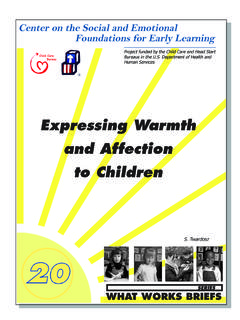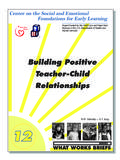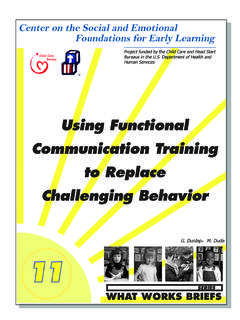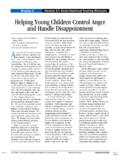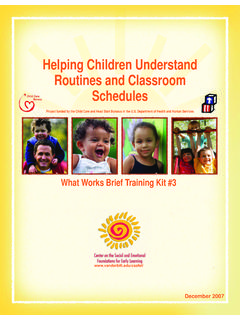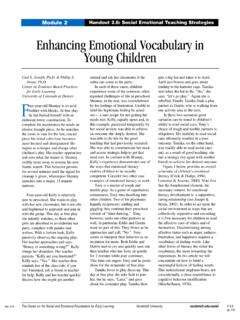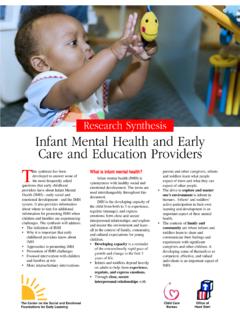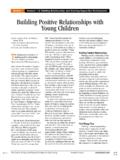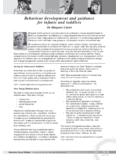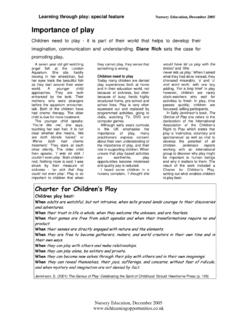Transcription of Teaching Your Child About Feelings - Vanderbilt …
1 Teaching your Child About Feelings Does This from Birth to Age 2. Sound Familiar? The Focus D. amon (6 months) and his sister Karenna (20 months) have arrived at their grandmother's house for the day. Even Young children experience many of the same emotions adults though this has been the morning routine for a few do. Children can feel angry, jealous, excited, sad, silly, months now, Damon cries and cries when his mother leaves. frustrated, happy, and worried. The difference is that very He is almost inconsolable, and it takes a great amount of time young children ages birth to 3 often lack the self- and comforting for him to calm down. Meanwhile, Karenna control and language skills to express their strong is pulling on her Granny's arm. She wants to play with her Feelings in ways that adults find acceptable. doll stroller but it is in the closet and she can't turn the knob.
2 Instead, babies and toddlers communicate strong She is not happy About waiting for her grandmother's emotions through their sounds and actions. For attention. Karenna swats her little brother, stamps her feet, example, Damon cried to show how difficult it and pulls on the doorknob with all her might. was saying good-bye to his mother. Big sister What would you do if this happened in your home? Karenna used her body swatting, stamping, Would you be feeling a little frustrated with one or maybe and yanking to show her frustration with even both children? Or would you be able to hang on to that waiting and her desire for the doll stroller. little piece of calm inside yourself and find the strength to GREENSPAN'S FIVE ESSENTIAL. soothe both your little ones? The Center on the Social and Emotional Foundations for Early learning Vanderbilt University What to Expect: Social and Emotional Skills Sometimes it is hard to imagine that very young babies are actively learning all the time, especially when they seem to spend most of their time sleeping, spitting up, or dropping strained carrots off the side of the high chair.
3 However, these early years are a critical time of learning for babies and toddlers. They are developing a foundation of social-emotional skills that they will build on for the rest of their lives. Here is a table that highlights the social-emotional skills your Child is learning and practicing at different ages. You can use this information to track how your Child is growing and changing from birth to age 3. GREENSPAN'S ESSENTIAL DEVELOPMENTAL STAGES. Developmental Goal Age Range What's Happening? your baby is: 1 learning how to be calm, how to accept soothing and Approximately comfort from a loved caregiver. Stage One: birth to 3 months learning to feel secure and interested in the world around Being Calm and Interested him. in All the Sensations of the trying to organize the information he is receiving from his World senses. your baby is: 2 becoming more focused on parents and other persons and Stage Two: Approximately things outside herself.
4 Falling in Love 2 to 10 months expressing emotional reactions of her own ( , smiles and frowns). expressing pleasure in others' company. your baby is: 3 purposefully using gestures (facial expressions, actions, and Approximately sounds) to communicate. Stage Three: 3 to 10 months responding to others' gestures with gestures of his own. Becoming a Two-Way realizing that he can use sounds and gestures to get his Communicator needs met by loved caregivers. your baby is: 4 learning to solve problems, like how to stack blocks in a tower. Stage Four: Approximately communicating in increasingly complex ways, using learning to Solve 9 to 18 months language, expressions, and gestures. Problems and Discovering learning what to expect from others, based on interactions a Sense of Self and experiences with parents and caregivers. developing a sense of self. your toddler is: 5 becoming skilled in symbolic thought ( , labeling images Stage Five: Approximately with words: Cookie!)
5 Creating Ideas 16 to 36 months using verbal means to communicate needs and desires. engaging in pretend play. learning to recognize and communicate her Feelings . learning to understand others' Feelings . (Greenspan 1999). The Center on the Social and Emotional Foundations for Early learning Vanderbilt University Good Habits to Get Into Practice Makes Perfect From birth to age 2, parents and caregivers have a big part to Children from birth to age 2 are learning a lot About play in helping children learn About Feelings . The most relationships, Feelings , soothing, and self-control. Here are important thing they can do is meet their babies ' needs, love some activities and strategies you can use with your Child to and nurture them, and comfort them when they are upset. help him or her begin to understand these big ideas: This type of responsive care helps very young children build a strong, loving relationship with the adults who care for From Birth to 18 Months them.
6 Feeling safe and secure, loved and nurtured, is the Keep your baby close. Put on some of your favorite biggest and most important ingredient for a Child 's healthy music, pick up your baby, and gently sway to the beat. social-emotional development. Gaze into your baby's eyes, smile at her, and hold her next There are other things that you can do to help your baby to your body. Leave the infant carrier in the car sometimes or young toddler begin to learn About Feelings and how to and hold your baby instead as you walk through the mall express them. These are all good habits to develop while or visit a friend. Cuddle and nuzzle your baby during some your Child is young so that they become part of your one-on-one time before bed. Shared moments like these everyday interactions and routines. help build a strong bond between the two of you. Read or tell stories About Feelings .
7 Choose books with Think About your Child 's temperament, or the way in brightly colored illustrations or pictures and not too much which she approaches and reacts to the world. text. Stories help your baby begin to understand emotions Temperament influences how intensely your Child like frustration, anger, pride, and joy. As you read, point to experiences Feelings (like frustration or anger) and how the faces in the book and say, She looks excited. He looks easily she can calm down. A Child who has strong Feelings surprised. As your Child grows, you can ask: Who is sad and reactions might have a harder time learning to control on this page? When he is able to talk, you can ask, How her emotions. Strong Feelings probably feel even bigger is that baby feeling? . and more overwhelming to her. On the other hand, a Child Make baby-safe puppets. Cut some pictures of babies who is easy going and allows changes or disruptions to and adults from magazines or catalogs.
8 Choose pictures roll off her back will probably have an easier time. that show a range of emotions. You can also use family Think About your own temperament. There is no right photos. Glue these to sturdy cardboard. If you'd like, you or wrong way to be. But paying attention to your own can cover them in clear contact paper so your baby can and your Child 's temperament gives you important drool on them! Let your baby choose a face to look at. Let information About each of your preferences. You can learn her look at the picture for as long as she'd like. Talk About how to adjust or match your caregiving to meet your the picture as your baby gazes at it: That baby is crying. Child 's needs and help her grow and learn. He is sad. Or, That baby is laughing. He is happy to play with his puppy.. Talk About Feelings . At first, babies and young toddlers Play peek-a-boo. Beginning at About 6 to 9 months, will probably not understand when you say, I can see babies really enjoy peek-a-boo.
9 Label your baby's Feelings you are angry because Jessie knocked your blocks over as you play: Uh oh, where's Mommy? Here I am Peek- or You are so sad that your balloon flew away. It might a-boo! Are you surprised? Are you happy to find even feel a little silly to talk to a tiny baby About his Mommy? Games like peek-a-boo are also ways you can Feelings . But this is an important part of helping your practice separations, reassuring your Child that I might go Child learn to identify and describe his emotions. When away, but I come back.. you use feeling words over and over as your Child grows, he will eventually come to understand what you mean. As your Child 's language skills develop, he will start to use these words on his own. Be a role model for expressing strong Feelings in healthy ways: I just spilled your cup of juice all over the floor! I am feeling really frustrated.
10 I think I am just going to close my eyes and count to five before I clean up.. Through your words and actions, you can show your Child how to manage strong Feelings and recover. And when you are having a hard time, it's okay to make sure your children are in a safe place and give yourself a couple of minutes to calm down. You are modeling self-control and showing that sometimes you need a break, too. The Center on the Social and Emotional Foundations for Early learning Vanderbilt University Look in the mirror. babies don't really know it's them in the mirror until they are About 2 years old. But you can help them become familiar with their own faces by making baby-safe mirrors part of your play. As the two of you look at your reflections, point to your smile and say, I am so happy. I am happy because I love being here with you! . Watch to see how your Child responds to sounds and textures.
